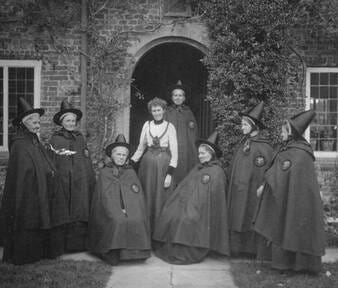🕯️ Was This a Secret Witches’ Coven Hiding in Plain Sight? Or Just a Mishap by the God-Fearing Folk of Rural Norfolk?

On the royal Sandringham Estate stands a curious relic of old England — The Hospital of the Holy and Undivided Trinity, founded in 1609 by the Earl of Northampton. It was never meant to raise eyebrows. Quite the opposite: a charitable home for “thirteen poor women of honest life and conversation.”
They were to be pious, discreet, and respectable — “no common beggar, harlot, or haunter of taverns.”
Yet one glance at the famous Victorian photograph of its residents tells a very different story.
Eight elderly women in dark cloaks and tall, pointed hats stand outside the ivy-clad doorway of the almshouse. Add in the historical note that there were always thirteen of them, and the mind can’t help but wander into witchier territory.
A church-sanctioned coven, hiding in plain sight?
The Bede Women of Castle Rising
Known locally as the Bede House, the almshouse sits not far from the royal residence at Sandringham. Its occupants were known as “Bedeswomen” — so called because they prayed (bede meaning “prayer” or “petition”). Three times a day, they were required to recite the Lord’s Prayer, the Creed, and a special blessing for the soul of their benefactor and his family.
In other words, thirteen elderly women chanting prayers in unison, day after day, in a small chapel surrounded by ancient Norfolk woodland.
No wonder the atmosphere seems a little uncanny.
The Witch-Hat Controversy
The black cloaks and hats were not meant to invoke dark powers. They were ceremonial uniforms — a holdover from the Tudor steeple hat, once fashionable among Puritans and respectable widows. By the 19th century, though, the look had become deeply anachronistic.
So when the Bedes were photographed in the 1880s, they appeared — unintentionally — like something straight from folklore. To modern eyes, they’re indistinguishable from the archetypal English witches: conical hats, austere faces, an air of secrecy.
A simple clerical costume, yes — but one that set imaginations alight.
Pious Widows… or the Last Wise Women?
Norfolk and Suffolk have always been lands where Christianity and older faiths overlap. The “cunning folk” and “wise women” never really vanished here — they simply found new names, new guises.
It’s easy to picture local villagers whispering about the Bedes’ daily rites: thirteen women, robed in black, murmuring prayers at dawn, noon, and dusk. Perhaps some thought the prayers carried more than piety — perhaps they were charms for protection, for healing, or for luck.
And who’s to say they weren’t? In rural England, intent often mattered more than doctrine.
A Holy Order, or a Hidden Tradition?
Whether through design or coincidence, the Bede women became a living symbol of England’s spiritual paradox — where witchcraft and worship have always shared the same ground.
Their black garb might have been chosen for modesty, but it also carried the aura of mystery. Their prayers were Christian, but rhythm and repetition can blur the line between devotion and enchantment.
So was it a case of godly women mistaken for witches?
Or did they, knowingly or not, carry forward something older — a quiet lineage of feminine power cloaked in Church respectability?
The Thirteen Bedes Remain
The Bede House still stands today. The rules are gentler now, the prayers optional, but single women from nearby parishes continue to live there. The photo, however, endures — a snapshot of piety that accidentally looks like sorcery.
And perhaps that’s the deeper truth of it. England has always preferred its mysteries disguised.
Monks who were alchemists. Nuns who were witches by another name.
And thirteen widows in black, saying their prayers on royal soil.
🕯️ Related Reading
Witchcraft on the Queen’s Land?
In 1964, police were called to the Queen’s Sandringham estate after the discovery of a naked clay effigy, a sheep’s heart, and thirteen hawthorn thorns nailed to the wall of a ruined church.
Was it the last gasp of English folk-sorcery — or something older still, stirring beneath royal soil?
Explore the full story in my companion investigation:
👉 Witchcraft on the Queen’s Land? A String of Macabre Effigies Found in Ruined Churches Could Have Been Part of an Elaborate “Death Curse” in Rural Norfolk


Hello there Doktor, you post some great content, I just wanted to comment, introducing myself and thanking you.
I’ve been here a month, and I write about history, through the perspective of old books (pre-1800).
This article discusses some of the most interesting claims from the 18th century:
https://open.substack.com/pub/jordannuttall/p/a-look-into-the-18th-century?r=4f55i2&utm_medium=ios
This article reads like a documentary. Feels like each line like cut scene. Many lessons contained in this. Not to mention the content is intriguing.